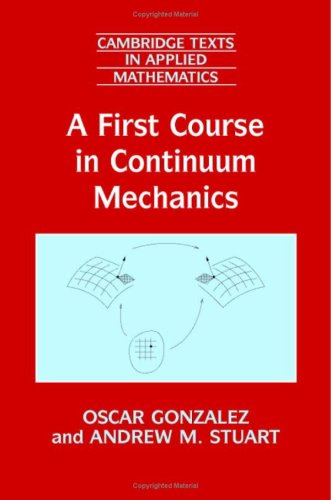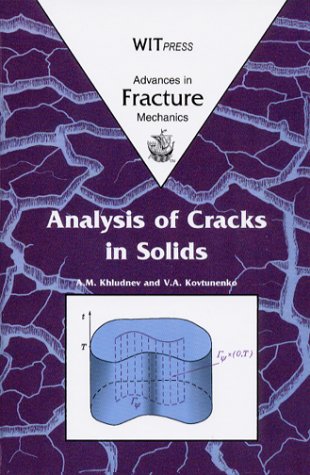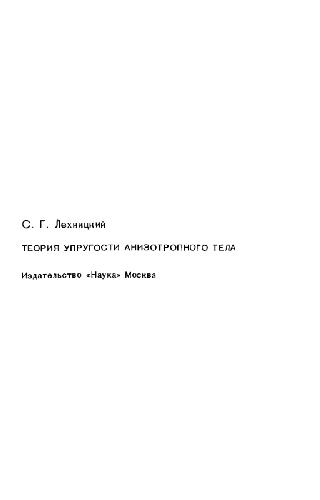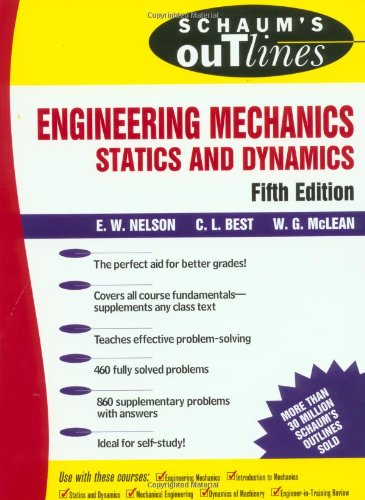Professor Oscar Gonzalez, Professor Andrew M. Stuart0521886805, 9780521886802, 0521714249, 9780521714242
Table of contents :
Cover……Page 1
Half-title……Page 3
Title……Page 5
Copyright……Page 6
Contents……Page 9
Preface……Page 17
1.1 Vectors……Page 21
1.1.1 Vector Algebra……Page 22
1.1.2 Scalar and Vector Products……Page 23
1.1.3 Projections, Bases and Coordinate Frames……Page 24
1.2.1 Summation Convention……Page 26
1.2.3 Frame Identities……Page 28
1.2.4 Vector Operations in Components……Page 29
1.2.5 Epsilon-Delta Identities……Page 30
1.3.1 Definition……Page 31
1.3.3 Representation in a Coordinate Frame……Page 33
1.3.4 Second-Order Dyadic Products, Bases……Page 34
1.3.5 Second-Order Tensor Algebra in Components……Page 35
1.3.6 Special Classes of Tensors……Page 36
1.3.7.1 Change of Basis Tensors……Page 39
1.3.7.2 Change of Representation……Page 40
1.3.8 Traces, Determinants and Exponentials……Page 41
1.3.9 Eigenvalues, Eigenvectors and Principal Invariants……Page 43
1.3.10 Special Decompositions……Page 45
1.3.11 Scalar Product for Second-Order Tensors……Page 46
1.4.1 Definition……Page 47
1.4.3 Representation in a Coordinate Frame……Page 48
1.4.4 Fourth-Order Dyadic Products, Bases……Page 49
1.4.5 Symmetry Properties……Page 50
1.5 Isotropic Tensor Functions……Page 51
Bibliographic Notes……Page 52
Exercises……Page 53
Answers to Selected Exercises……Page 58
2.1.1 Points, Tensors and Representations……Page 64
2.1.2 Standard Norms, Order Symbols……Page 65
2.2.1 Derivatives, Gradients……Page 66
2.2.2 Divergence……Page 70
2.2.3 Curl……Page 72
2.2.4 Laplacian……Page 73
2.3.1 Divergence Theorem……Page 74
2.3.2 Stokes’ Theorem……Page 77
2.3.3 Localization Theorem……Page 78
2.4 Functions of Second-Order Tensors……Page 79
2.4.1 Scalar-Valued Functions……Page 80
2.4.2 Tensor-Valued Functions……Page 83
Exercises……Page 85
Answers to Selected Exercises……Page 90
3.1 Continuum Bodies……Page 95
3.2.1 Mass Density……Page 96
3.3.1 Body Forces……Page 97
3.3.2 Surface Forces……Page 98
3.3.2.2 Cauchy’s Postulate, Law of Action and Reaction……Page 99
3.3.3 The Stress Tensor……Page 102
3.4.1 Preliminaries……Page 105
3.4.2 Necessary Conditions……Page 106
3.4.3 Local Equations……Page 107
3.5.1 Simple States of Stress……Page 110
3.5.2 Principal, Normal and Shear Stresses……Page 112
3.5.3 Maximum Normal and Shear Stresses……Page 113
3.5.4 Spherical and Deviatoric Stress Tensors……Page 114
Bibliographic Notes……Page 115
Exercises……Page 116
Answers to Selected Exercises……Page 122
4.1 Configurations and Deformations……Page 132
4.2 The Deformation Map……Page 133
4.3.1 The Deformation Gradient F……Page 134
4.3.2 Interpretation of F, Homogeneous Deformations……Page 135
4.3.2.1 Translations and Fixed Points……Page 136
4.3.2.2 Rotations and Stretches……Page 137
4.3.2.3 Extensions……Page 138
4.3.2.4 Summary……Page 139
4.3.3 The Cauchy–Green Strain Tensor C……Page 140
4.3.4 Interpretation of C……Page 141
4.3.5 Rigid Deformations……Page 144
4.3.6 The Infinitesimal Strain Tensor E……Page 145
4.3.7 Interpretation of E……Page 146
4.4 Motions……Page 148
4.4.1 Material and Spatial Fields……Page 149
4.4.3 Time Derivatives……Page 150
4.4.4 Velocity and Acceleration Fields……Page 151
4.5.1 Rate of Strain Tensor L and Spin Tensor W……Page 154
4.5.3 Vorticity……Page 155
4.6 Change of Variables……Page 156
4.6.1 Transformation of Volume Integrals……Page 157
4.6.2 Derivatives of Time-Dependent Integrals……Page 159
4.6.3 Transformation of Surface Integrals……Page 161
Bibliographic Notes……Page 164
Exercises……Page 165
Answers to Selected Exercises……Page 174
5.1 Motivation……Page 187
5.2.1 Conservation of Mass and Laws of Inertia……Page 190
5.2.2.1 Temperature and Heat……Page 192
5.2.2.2 Kinetic Energy, Power of External Forces and Net Working……Page 194
5.2.2.3 Internal Energy and The First Law……Page 195
5.2.2.4 Entropy and the Second Law……Page 196
5.3.1 Conservation of Mass……Page 199
5.3.2 Balance of Linear Momentum……Page 202
5.3.3 Balance of Angular Momentum……Page 203
5.3.4 Characterization of Net Working……Page 205
5.3.5 First Law of Thermodynamics……Page 206
5.3.6 Second Law of Thermodynamics……Page 207
5.3.7 Summary……Page 209
5.4.1 Conservation of Mass……Page 210
5.4.2 Balance of Linear Momentum……Page 211
5.4.4 Characterization of Net Working……Page 213
5.4.5 First Law of Thermodynamics……Page 215
5.4.6 Second Law of Thermodynamics……Page 216
5.4.7 Summary……Page 217
5.5.1 Superposed Rigid Motions……Page 219
5.5.2 Axiom of Frame-Indifference……Page 220
5.6 Material Constraints……Page 222
5.7 Isothermal Considerations……Page 224
Bibliographic Notes……Page 227
Exercises……Page 228
Answers to Selected Exercises……Page 233
6 Isothermal Fluid Mechanics……Page 241
6.1.1 Definition……Page 242
6.1.2 Euler Equations……Page 243
6.1.3 Frame-Indifierence Considerations……Page 245
6.1.5 Initial-Boundary Value Problems……Page 246
6.1.6 Motion Map, Other Boundary Conditions……Page 248
6.1.7 Irrotational Motion, Bernoulli’s Theorem……Page 249
6.2 Elastic Fluids……Page 254
6.2.2 Elastic Fluid Equations……Page 255
6.2.3 Frame-Indifference Considerations……Page 256
6.2.4 Mechanical Energy Considerations……Page 257
6.2.5 Initial-Boundary Value Problems……Page 258
6.2.6 Irrotational Motion, Generalized Bernoulli’s Theorem……Page 259
6.2.7 Linearization……Page 263
6.3.1 Definition……Page 265
6.3.2 Navier–Stokes Equations……Page 266
6.3.3 Frame-Indifference Considerations……Page 268
6.3.5 Initial-Boundary Value Problems……Page 270
6.4 Kinetic Energy of Fluid Motion……Page 272
Exercises……Page 276
Answers to Selected Exercises……Page 282
7 Isothermal Solid Mechanics……Page 291
7.1.1 Definition……Page 292
7.1.2 Elasticity Equations……Page 294
7.1.3 Frame-Indifference Considerations……Page 295
7.1.4 Initial-Boundary Value Problems……Page 297
7.1.5 Isotropy, Simpli.ed Response Functions……Page 299
7.2.1 Definition……Page 302
7.2.2 Frame-Indifference Considerations……Page 303
7.2.3 Mechanical Energy Considerations……Page 305
7.2.4 Common Models……Page 307
7.3 Linearization of Elasticity Equations……Page 308
7.3.1 Linearized Equations, Elasticity Tensors……Page 309
7.3.2 Initial-Boundary Value Problems……Page 310
7.3.3 Properties of Elasticity Tensors……Page 311
7.3.4 Equation of Linearized, Isotropic Elasticity……Page 315
7.4.1 Definition……Page 316
7.4.2 General Properties……Page 318
Bibliographic Notes……Page 321
Exercises……Page 322
Answers to Selected Exercises……Page 332
8 Thermal Fluid Mechanics……Page 344
8.1.1 Definition……Page 345
8.1.2 Gas Dynamics Equations……Page 348
8.1.3 Frame-Indifference Considerations……Page 350
8.1.4 Thermodynamical Considerations……Page 351
8.1.5 Entropy Formulation, Isentropic Equations……Page 354
8.2 Compressible Newtonian Fluids……Page 356
8.2.1 Definition……Page 357
8.2.2 Compressible Navier–Stokes Equations……Page 359
8.2.3 Frame-Indifference Considerations……Page 361
8.2.4 Thermodynamical Considerations……Page 363
8.2.5 Initial-Boundary Value Problems……Page 365
Bibliographic Notes……Page 367
Exercises……Page 368
Answers to Selected Exercises……Page 370
9 Thermal Solid Mechanics……Page 375
9.1.1 Definition……Page 376
9.1.2 Thermoelasticity Equations……Page 379
9.1.3 Thermodynamical Considerations……Page 381
9.1.4 Frame-Indifference Considerations……Page 384
9.1.5 Initial-Boundary Value Problems……Page 387
9.2.1 Preliminaries……Page 390
9.2.2 Linearized Equations, Thermoelasticity Tensors……Page 391
9.2.3 Initial-Boundary Value Problems……Page 394
Bibliographic Notes……Page 396
Exercises……Page 397
Answers to Selected Exercises……Page 401
Bibliography……Page 406
Index……Page 410
1 Tensor Algebra……Page 417
2 Tensor Calculus……Page 430
3 Continuum Mass and Force Concepts……Page 439
4 Kinematics……Page 454
5 Balance Laws……Page 474
6 Isothermal Fluid Mechanics……Page 486
7 Isothermal Solid Mechanics……Page 500
8 Thermal Fluid Mechanics……Page 519
9 Thermal Solid Mechanics……Page 526







Reviews
There are no reviews yet.